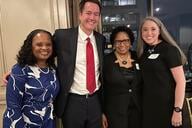You have /5 articles left.
Sign up for a free account or log in.
A presidential search and the launch of a new administration are among the highest-visibility occasions in the life of an institution. Elevated expectations and intense public scrutiny raise the stakes for getting every aspect of the communications process exactly right.
Unfortunately, communicating around a presidential search is something for which organizations are often underprepared. The first reason is obvious: those muscles aren’t flexed every day or even every year. Even as presidential tenures continue to shorten, the appointment of a new campus leader is still a relatively rare event. Secondly, with more frequent employee turnover depleting institutional memory, there may be few experienced professionals on campus to guide communications strategy when such insight is needed most.
While every campus context is different, understanding the communications sensibilities informing a presidential search and president-designate launch can help those involved to make thoughtful choices.
Phase 1: Communicate to Reassure
A president’s announcement of their retirement or departure is inevitably unsettling, even if widely anticipated. It’s a destabilizing moment, a transition point when individuals can experience heightened emotions ranging from uncertainty about their roles to excitement about what the future holds. Compounding the disorientation is the fact that, as a search forms, a new institutional voice enters the scene. Because a sitting president appropriately has no role in the selection of their successor, a search is one of the few times that a trustee—either the board chair or the search chair—communicates directly with the community. Fulfilling one of the board’s most important roles, that individual announces the search and search committee, invites input from constituencies, and authorizes communications updates, with the board ultimately making the appointment. Although the board’s heightened presence may be unfamiliar to many, this is a typical course of affairs. From a communications perspective, it is a valuable opportunity to both reassure the community about institutional continuity and make the campus governance process clear and transparent to all.
Phase 2: Launch Loudly
At the outset, when a search is launched and a search committee formed, a communicator’s job is to cast the widest possible net, ensuring every member of their campus and alumni community is aware of the process. This is a moment for overcommunication, ensuring that everyone affiliated with the institution is invited, via multiple channels, to weigh in on what is needed in the next leader. A robust website for the search, through which feedback is welcomed, communications aggregated and answers provided to frequent questions, is an essential resource. Communicating frequently and robustly in this early phase of the search will generate useful community input and buy-in; equally important, it will pay dividends in trust down the road when the privacy and confidentiality often needed in later phases of the search necessarily limit how much search leaders can say.
It’s also important at this stage to manage expectations around updates and information sharing. Being clear about the cadence of communications to come ensures that, for example, a period in which updates are paced more widely apart is understood as a normal factor in the process and not misinterpreted as a stumble or impasse in committee progress.
Finally, it’s worth noting that the launch of a search often thrusts a chief communications officer, a board chair and/or a search chair into a new and fast-moving alliance, one to which each might bring little prior experience. The secretary of the board also plays a vital liaison role between the search and communications functions. Having a shared understanding of communications expectations and cadence from the outset is vital to success at all stages.
Phase 3: Balance Disclosure and Privacy
The working phase of a presidential search, when a committee is deep in its deliberations, screening, vetting and wooing candidates, is often the most challenging phase for communicators. Ensuring candidates’ privacy and committee confidentiality are vital considerations in attracting top talent and enabling the committee to discern thoughtfully among them. Updates at this stage of the process typically emphasize the depth of interest in the position, the strong pool the committee is reviewing, the competitiveness of the field and the committee’s unity around finding the optimal candidate for the job. Even if multiple finalists are invited to campus for public or semipublic events, attention to confidentiality can still play a role depending on the openness of the process to which the institution has committed.
Phase 4: Consider the Frame
The announcement of the president-designate is, unsurprisingly, intense, fast-moving and increasingly elaborate. The more quickly the news of a new leader is announced, the lower the chance of a leak, whether from the appointee’s new institution or their current campus. But speed must be matched with care: the narrative surrounding the individual is not only a statement of their qualifications but, more broadly, a framework for the direction of the institution. The community needs to see its desires for the next leader reflected in the selection. It needs to recognize the college or university’s past in relation to its future. Similar attention should be paid to the president-designate’s first campus appearance, ensuring that that moment signals maximum welcome and pride and doesn’t, for example, put the new person in a position to answer for past decisions nor be lobbied publicly by special interests. At this point in the process, it’s useful to remember the primacy effect, the human tendency to be influenced disproportionately by first impressions. At this stage, every choice by the institution and its incoming leader sends a signal, positive, negative or neutral, with the potential to resonate into the next administration.
An inauguration may serve as the ceremonial launch of a new leader, but a presidency’s beginning can arguably be traced back to the outset of the search itself. Optimizing presidential search communications at every key moment—from announcement to committee work to campus launch—requires a strong communications-board partnership, carefully managed expectations and thoughtful attention to detail. Approached thoughtfully, the process both positions the individual for success and makes a resonant statement about the institution’s resilience, responsiveness and openness to change.
As founder and principal of L. Fenlason Consulting and senior counselor at RW Jones Agency, Laurie Fenlason advises higher education boards, leaders and teams on strategy, visibility and high-stakes communications. She previously served as vice president for public affairs and strategic initiatives at Smith College and in news and public affairs roles at the University of Michigan and the University of Pennsylvania.




